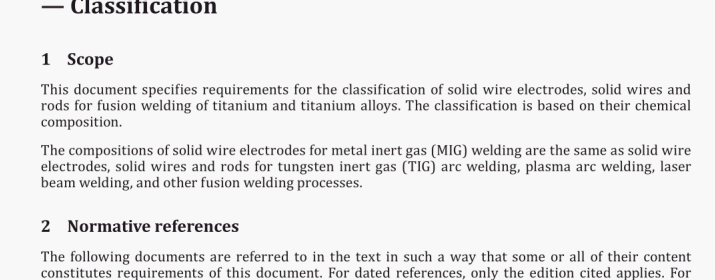Welding consumables

BS EN ISO 24034:2020 pdf free.Welding consumables一Solid wire electrodes, solid wires and rods for fusion welding of titanium and titanium alloys一Classification.
This document specifies requirements for the classification of solid wire electrodes, solid wires and rods for fusion welding of titanium and titanium alloys. The classification is based on their chemical composition.
The compositions of solid wire electrodes for metal inert gas (MIG) welding are the same as solid wire electrodes, solid wires and rods for tungsten inert gas (TIG) arc welding, plasma arc welding, laser beam welding, and other fusion welding processes.
2 Normative references
The following documents are referred to in the text in such a way that some or all of their content constitutes requirements of this document. For dated references, only the edition cited applies. For undated references, the latest edition of the referenced document (including any amendments) applies.
ISO 544, Welding consumables — Technical delivery conditions for filler materials and fluxes — 7pe of product, dimensions, tolerances and markings
ISO 14344, Welding consumables — Procurement offiller materials and fluxes
ISO 80000-1:2009, Quantities and units — Part 1: General. Corrected by ISO 80000-1:2009/Cor 1:2011
3 Terms and definitions
No terms and definitions are listed in this document.
ISO and IEC maintain terminological databases for use in standardization at the following addresses:
— ISO Online browsing platform: available at httpsj/wwwiso.org/obp
— I EC Electropedia: available at http://www.electropedia.org/
4 Classification
The classification is divided Into two parts:
a) the first part gives a symbol indicating the product to be identified, see £1;
b) the second part gives a symbol indicating the chemical composition of the solid wire electrodes, solid wires and rods, see Table 1.
5 Symbols and requirements
5.1 Symbol [or the product
The symbol for the solid wire electrodes, solid wires and rods shall be S.
The numerical symbols in Table 1 indicate the chemical composition of a solid wire or rod, determined under the conditions given in Clause 7. The first two digits indicate the alloy group. See Annex A for an explanation of the numerical symbols.
The optional additional chemical symbols in Tabici. indicate the chemical composition and include an indication of the characteristic alloying elements.
6 Mechanical properties
Mechanical properties of all-weld metal or welded joints are not part of this classification.
7 Chemical analysis
Chemical analysis shall be performed on specimens of the product or the stock from which it is made. See also footnote c to Table 1. Any analytical technique may be used but, in cases of dispute, reference shall be made to established published methods, agreed between the contracting parties.
8 Rounding procedure
Actual test values obtained shall be subject to ISO 80000-1:2009, B.3, Rule A. If the measured values are obtained by equipment calibrated in units other than those of this document, the measured values shall be converted to the units of this document before rounding. If an average value is to be compared to the requirements of this document, rounding shall be done only after calculating the average. The rounded results shall fulfil the requirements of the appropriate table for the classification under test.
9 Retests
If any test fails to meet the requirement(s), that test shall be repeated twice. The results of both retests shall meet the requirement. Specimens for the retest may be taken from the original test assembly or sample or from one or two new test assemblies. For chemical analysis, retests need only be for those specific elements that failed to meet the requirement. If the results of one or both retests fail to meet the requirement, the material under test shall be considered as not meeting the requirements of this document for that classification.
In the event that during preparation, or after completion of any test, it is clearly determined that prescribed or proper procedures were not followed in preparing the weld test assembly or sample(s) or test specimen(s), or in conducting the tests, the test shall be considered invalid. This determination is made without regard to whether the test was actually completed, or whether the test results met, or failed to meet, the requirements. That test shall be repeated, following proper prescribed procedures. In this case, the requirement for doubling the number of test specimens does not apply.
10 Technical delivery conditions
Technical delivery conditions shall meet the requirements of ISO 544 and ISO 14344.BS EN ISO 24034 pdf free download.Welding consumables